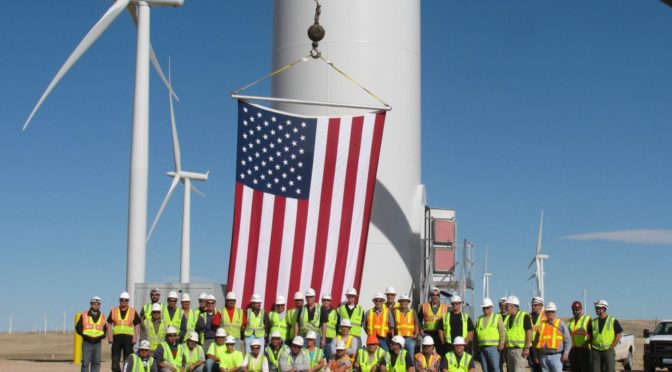Most powerful land-based wind turbines to date emerge as U.S. wind power continues strong growth.
even states, from Nebraska to Massachusetts, will soon build enough wind turbines to more than double their capacity to generate clean and reliable wind energy, according to the American Wind Energy Association (AWEA) U.S. Wind Industry Third Quarter 2018 Market Report released today. The report also reveals the first firm orders for 4-megawatt (MW) land-based wind turbines, nearly twice as powerful as the average wind turbine installed in 2017.
Nationally, the low cost and reliability of wind power continued to drive strong industry growth in the third quarter. Significantly, seven states now have enough wind projects under construction or in advanced stages of development to more than double their capacity to generate electricity from the wind when they are completed. Those include heartland states with land-based wind under development—Arkansas, Nebraska, New Mexico, South Dakota, and Wyoming—as well as coastal states Maryland and Massachusetts, where offshore wind is poised to scale up.
“The wind is always blowing in the U.S. and the latest wind turbine technology helps affordably and reliably put more of that natural resource to work,” said Tom Kiernan, CEO of AWEA. “With projects underway in over 30 states, wind is rapidly expanding as a major source of American energy, good jobs and clean air.”
As the industry expands, wind turbines are themselves growing much more powerful and efficient at delivering low-cost, clean energy to American homes and businesses. Longer blades are helping turbines capture more of the wind resource blowing past. New wind farms also leverage big data and machine learning to improve power output and reduce downtime by anticipating maintenance problems before they arise. These advances drive down costs and translate into major efficiency gains.
The average utility-scale wind turbine installed in 2017 was rated at 2.32 MW, enough to power over 750 American homes for a full year. More powerful wind turbines are on the horizon. In the third quarter, new orders for wind turbines include land-based turbines above 4 MW for the first time, which are capable of powering 1,400 homes a year.
To put the significance of this technological advance in context, only two operating land-based wind farms currently use turbines rated above 3.5 MW. That will soon change as the industry quickly embraces new technology; there are currently 12 more projects in development that plan to use turbines rated above 3.5 MW. Offshore wind turbines can be even more powerful, with turbines typically rated above 6 MW.
U.S. wind farms now represent a total 90,550 MW of electricity generating capacity, with 612 MW installed in the third quarter of 2018. That’s enough wind power capacity to power 27 million average U.S. homes, with more than 54,000 wind turbines operating in 41 states plus Guam and Puerto Rico.
There is a strong near-term wind farm pipeline comprised of 37,965 MW of wind power capacity. These wind farms are either actively under construction or have entered advanced stages of development through a major milestone such as placing a turbine order or finding a buyer for their power. During the third quarter, projects totaling 2,180 MW started construction and a further 2,327 MW entered advanced development.
Wind power’s low and stable prices continued to drive strong demand from utilities and corporate customers in the third quarter. Over the last several years, non-utility customers including major consumer brands, cities, universities, and even the U.S. military have together become a major source of demand for wind power. In just three quarters of 2018, non-utility wind energy customers signed contracts for more wind power capacity than any other year. That includes 945 MW purchased in the third quarter by customers including first-time buyers Smucker’s, Boston University, and Royal Caribbean Cruise Lines. Cumulatively, non-utility purchases of wind power capacity in the U.S. have exceeded 10,000 MW.
Utilities signed contracts for 1,522 MW of wind capacity in the third quarter, including the largest procurement of U.S. offshore wind to-date from the 800 MW Vineyard Wind project by Eversource Energy, National Grid, and Unitil. Every day, utilities and tens of millions of U.S. electricity consumers rely on wind power as an affordable and highly predictable part of the energy mix. Wind supplies over 30 percent of the electricity generated in four states.
Increased reliance on affordable wind power benefits consumers, fuels economic growth, boosts U.S. energy security, and leads to a cleaner, healthier environment for everyone. Wind turbines don’t require expensive fuel to produce electricity, but they must be assembled, built and operated by over 105,000 Americans who work in the wind industry. Wind farms are often paired with agriculture, an advantage for farmers and ranchers who volunteer to lease small portions of their land in exchange for drought-proof payments totaling $267 million a year. And using wind power creates healthcare savings for Americans worth an estimated $8 billion a year through avoided air pollution that triggers smog and asthma attacks.


